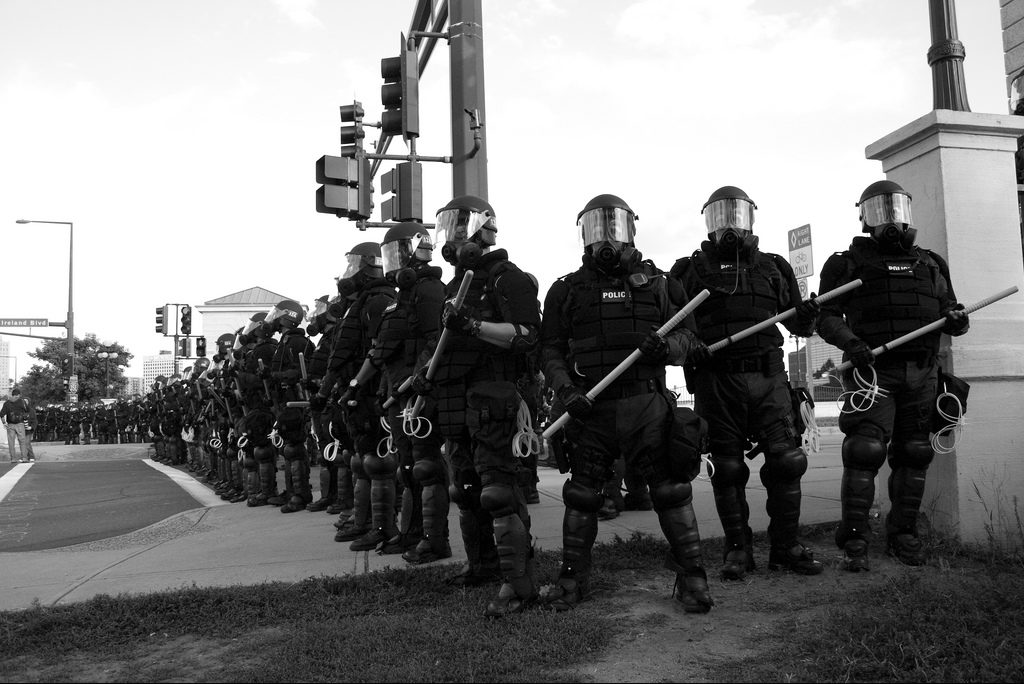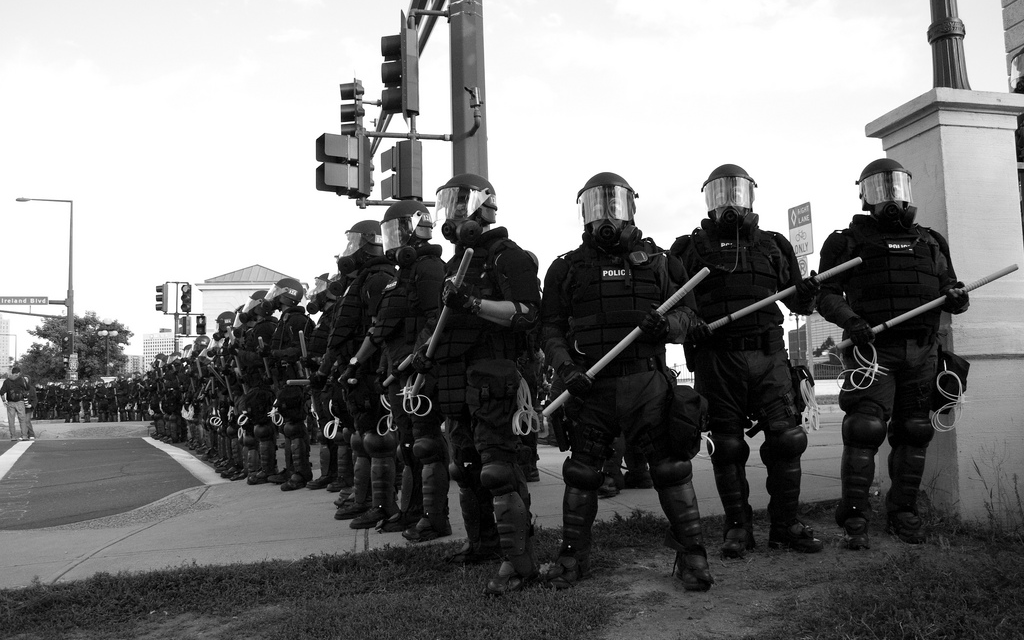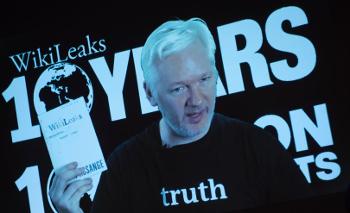
By Lisa Haven
“The Civil Rights Division of the Department of Justice has provided oversight and recommendations for improvement of police services in a number of cities with consent decrees. This is one of the most effective ways to reduce discrimination in law enforcement and it needs to be beefed up and increased to cover as many of the 18,000-plus local law enforcement jurisdictions.” UN Rapporteur Maina Kai (Representatives of the UN Human Rights Council)
Eerie to say the least! 18,000 “local” law enforcements under the oversight of the Department of Justice, a federal organization? What sense does that make? Aren’t the “LOCAL” law agencies supposed to be controlled by the state, and yet now the suggestion is to put them under regulations of the DOJ? Is this not one giant step towards the federalization of our “local” PD’s? And don’t they already have “federal forces?” The “Federal” Bureau of Investigation (FBI), Drug Enforcement Administration (DEA), Bureau of Alcohol, Tobacco, Firearms and Explosives (ATF), Department of Homeland Security (DHS), US Immigration and Transportation Security Administration (TSA), US Customs and Border Protection (CBP), etc.….. I do believe we are inching very close to the fictional police state from George Orwell’s, 1984.
All that and MUCH MORE in this URGENT report…..
Now consider this, in December of 2014, President Barack Obama secretly signed an executive order creating a Presidential Task Force geared at 21st Century Policing. This Force seeks not only to identify ways for police departments to better themselves but also promotes increased interaction of our local police officers in our schools, businesses, communities and many other aspects of our lives. The main objective of the force is to get the public acquainted with their presence and to establish a trust connection in communities.
While this all sounds like “sunshine and lollipops” we must consider this a step towards the integration of preparation for a full police state. Considering this task force comes on the heels of Jade Helm—who’s object it is to gain public trust as well— we must consider the possibility. What are the chances that both Jade Helm, (a military training exercise) and the Presidential Task Force for the 21st Century (a police objective report) are geared at gaining the publics trust? Could there be a link between them and martial law preparation? Or am I thinking too much into it?
According to the Presidential Task Force for the 21st Century Policing Report the main objective is to promote: “Trust between law enforcement agencies and the people they protect and serve…” It further states that “People are more likely to obey the law when they believe those who are enforcing it have the right—the legitimate authority—to tell them what to do.” (page1)
The report also exposes the goal of having local police highly involved in our communities, schools, businesses and lives on a daily basis, “The mission of the task force is to examine how to foster strong, collaborative relationships between local law enforcement and the communities they protect…” (page 1)
While it seems like a good thing, the question needs to be asked; why is there an uptick in readying the community to trust the military through Jade Helm and the police force through the Presidential Task Force? Do they fear something is around the corner?
But that’s not all the Presidential Task Force Report Reveals. I also found these interesting facts enclosed in the document:
Pages 2 and 3 describe seven sessions conducted as a result of this task force that discuss a wide range of recommendations from faith leaders, law enforcement, academics, and more. It includes:
- Building Trust and Legitimacy (gaining trust of community)
- Policy and Oversight (policies)
- Technology and Social Media (How to use technology to help police and privacy issues)
- Community Policing and Crime Reduction (community policing and more trust building.)
- Training and Education (Of which Jade Helm is a part of, just how to train)
- Officer Safety and Wellness
- Future of Community Policing (how to implement procedures)
Some recommendations on how to implement the above polices are as follows:
“The President create a National Crime and Justice Task Force to review and evaluate all components of the criminal justice system of rate purpose of making recommendations to the country on comprehensive criminal justice reform.” (pg. 3) It further stated the reason why was because “the justice system alone cannot solve many of the underlying conditions that give rise to crime. It will be through partnerships across sectors and at every level of government that we will find the effective and legitimate long-term solutions to ensuring public safety.”(pg. 4)
This clearly could indicate a future partnership of sorts between the local law enforcement, the federal government, and even branches of local businesses, churches, schools, etc. The problem with this is that it could turn into a mesh pot of information gathered against each individual kicking our privacy issues out the door. Further when our local police are continually interacting through “partnerships” we are likely to see an increase in police activity in our cities. Here are a few more recommendations promoting such interactions:
“Community policing should be infused throughout the culture and organizational structure of law enforcement agencies.” (pg. 43)
“Law enforcement agencies should develop programs that create opportunities for patrol officers to regularly interact with neighborhood residents, faith leaders, and business leaders.” (pg.46)
“Law enforcement agencies should work with schools to develop and monitor school discipline policies with input and collaboration from school personnel, students, families, and community members. These policies should prohibit the use of corporal punishment and electronic control devices.” (pg.48-49)
“Communities and law enforcement agencies should restore and build trust between youth and police by creating programs and projects for positive, consistent, and persistent interaction between youth and police.” (pg. 50)
“The U.S. Department of Justice should explore public-private partnership opportunities, starting by convening a meeting with local, regional, and national foundations to discuss the proposals for reform described in this report and seeking their engagement and support in advancing implementation of these recommendations.” (pg. 71)
Am I reading to much into this? Or is there a link to be made? I guess the ultimate decision is yours. But either way, don’t say I didn’t warn you!
For More Information See:
http://www.lifezette.com/polizette/un-backs-secret-obama-takeover-of-police/
https://www.aclu.org/news/aclu-northern-ca-hails-landmark-racial-profiling-settlement
https://en.wikipedia.org/wiki/Federal_Bureau_of_Investigation
https://en.wikipedia.org/wiki/Law_enforcement_in_the_United_States
http://www.un.org/en/peacekeeping/sites/police/
http://strongcitiesnetwork.org/
http://www.llrmi.com/articles/legal_update/consent_decrees.shtml
Task Force Stream: http://www.taskforceonpolicing.us/
Task Force Document: http://www.cops.usdoj.gov/pdf/taskforce/Interim_TF_Report.pdf
1033 Program Through NDAA: http://fas.org/sgp/crs/natsec/R43701.pdf
Executive Order: http://www.presidency.ucsb.edu/ws/?pid=108088










The “initiatives” to reform, or to shape the future with regard to ever aspect of life on this earth, are coming from the World Economic Forum, not the UN!
https://www.weforum.org/system-initiatives
Reblogged this on Patriot Family Survival and commented:
http://www.PatriotFamilySurvival.com/
With regard to “privacy issues”, THERE IS NO PRIVACY! Get real! Information Technologies, overt and covert, obtained with and without our consent, are used to gather and store all kinds of information on us, including biometric/bioelectric data. All this information is used to create a “profile” on each and every “citizen” in each “community”. Those not willing to conform to the “initiatives” of the World Economic Forum, specifically with regard to the electronic “mark” all will need in order to “buy or sell”, will become instant criminals.
“Countries across the globe are increasingly moving towards cashless societies…”
http://betanews.com/2016/04/11/how-phone-agnostic-beacon-technology-will-revolutionize-mobile-payments/
Messed up a bit with the second sentence which should read, “Information Technologies, overt and covert, are used to gather and store information on us, with or without our consent, including biometric/bioelectric data.”
http://lifeboat.com/blog/2016/08/e-government-a-powerful-tool-to-implement-global-sustainability-goals-un-survey-finds-un-news-centre
http://www.un.org/apps/news/story.asp?NewsID=54617#.V6ab88KYDIV
“Transhumanist candidate Zoltan Istvan urges spending less on war and more on the scientific quest to defeat death.”
Jesus already defeated death! He was resurrected by the power of his Father, the Creator of All!
“Cyberthieves might be mining personal information from your brainwaves at this very moment.”
http://lifeboat.com/blog/2016/08/hackers-could-get-inside-your-brain-warns-experts#more-28680
The humanitarian, and now trans-humanitarian, system of doctrine learned, preached, and practiced by the “elite” during the “Age of Enlightenment”, has been handed down and taught to “the public” over many years via the “public” education system, i.e., the secular liberal humanist school system. Knowingly and unknowingly, a majority of humanity are engaged in attempting to create their own future by attempting to construct an “eighth” (and final) high tech hybrid “civilization”! The “elite” and their “citizens” are involved in attempting to create a new “civilization”. The system of doctrine they practice considers Jesus Christ to be just another man and not divine. Their system of doctrine is predicated on the idea that man’s chief duty is to work for the welfare and interests of the human race. Their system of doctrine teaches others that human perfectibility (specifically immortality) is attainable through the developments and applications of their sciences and technologies. Their system of doctrine teaches that man’s obligations are limited to and dependent alone on man and the development of human relationships, which is what “social networking” is really all about. Most importantly, their system of doctrine teaches that their goals are attainable without the divine aid of the Most High God, his Son, Jesus Christ, and the Holy Spirit!
Just watched a video in which Vladimir Putin speaks of the Russian nations “morals” and “values” vs the West, which has no morals, and he is, without question, correct in that regard. Putin is a Royal Arch Freemason however, and if you want to find out what “morals” and “values” they uphold read “Morals and Dogma” by Albert Pike, whose statue sits in Washington, D.C., or read “The LODGE and the CRAFT” by Rollin C. Blackmer. Perhaps you can find a copy of the book titled “Magic and the Supernatural” in which a picture shows those being initiated into Freemasonry having to spit and stomp on a replica of Jesus on a cross, and deny the Son of God! George Washington, a Freemason, is quoted saying, “The Government of the United States of America is not in any sense founded on the Christian Religion.”! He is absolutely 100% correct!
“Who is the liar but he who denies that Jesus is the Christ? This is the antichrist, he who denies the Father and the Son. No one who denies the Son has the Father.” (The First Letter of John, chapter 1, verse 22, Revised Standard Version of the Holy Bible, printed 1952)
http://www.charlotteobserver.com/opinion/op-ed/article94019107.html
No way to know if this is a joke or not. Have to wait until tomorrow for confirmation.
CORRECT. YOU MAY BE ABLE TO PUSH LIES IN THE CARPET FOR A TIME, BUT THE TRUTH COMES ALONG AND ACTS LIKE A MASSIVE VACUUM CLEANER.
Apparently, according to news reports today, the Islamic state of Iran is ready to attack the Jewish state of Israel. It would appear that the words of Freemason Albert Pike concerning a 3rd World War being fomented by them between the political Zionists (the Jewish-Christian State of Israel created nearly 70 years ago) and the leaders of the Islamic World (the Moslem Arabic World) are about to come true. Could this be the real reason why all the military buildup, all the exercises, and activity in the US and in various regions of the world? Seems plausible to me. .
Iran Is Ready To Attack Israel
https://www.yahoo.com/
False Flag “event” coming?
http://www.tomatobubble.com/hitler_democracy.html
The government of the USA was designed as a representative “democracy” with three branches, they being the Executive, the Judicial, and the Legislative, but behind the scenes, the Freemason’s controlled everything via the capitalist economic system! Its obvious the will of the people, carnal man, and especially the will of the Freemason’s, is absolutely NOT aligned with the will of the Most High God. In any “democracy”, whether actual or representative, the will of carnal man is “setup” as the highest authority. Today, the will of carnal man is being gathered together in an global collective, or “noosphere”, which is being “setup” as the highest authority, overseen by a godlike artificial intelligence created in the image of the “beast”, the carnal spirit that indwells carnal man. This act is the “abomination that makes desolate” spoken of by the true prophets of the Most High God!
Unbeknownst to most people, especially the psuedo-Christian “community”, the leadership in the Jewish state of Israel are opposed to the true doctrine of Christ, as are the leadership in Washington, past and present. The Jewish leadership when Jesus was in the flesh on this earth were vehemently opposed to Jesus and his words. Jesus argued against the teachings of the Pharisees, the Sadducees, the rabbi’s in Jerusalem and Alexandria in their synagogues constantly. Jesus told them that they did the will of their father, the devil! They sought to kill him on numerous occasions and eventually they convinced a Roman governor to execute him on a cross. He was, however, resurrected from death by the power of his Father, the Most High God (No manmade sciences and technologies needed!) All this is documented in the correct versions of scripture, which includes the Revised Standard Version of the Holy Bible, if you care to read it.
By the way, the only true “faith” is to acknowledge that Jesus is The Christ, that he lived, died, and was resurrected from death by the power of GOD.
My statement won’t sit well with the “Universal Unitarian’s”, guarranteed!
THIS WAY IN THE ULTIMATE END IN THE TIME CLOCK OF MANKIND, THE MARK OF THE BEAST WILL TRULY SEPARATE ALL OF US; THERE SHALL BE ONLY TWO DIVISIONS IN THIS WORLD PRIOR TO THE RETURN OF JESUS CHRIST, THOSE THAT SHALL WORSHIP HIM, AND THOSE THAT SHALL worship satan, BOTH OF THESE DIVISIONS SHALL INCLUDE BOTH JEW AND GENTILE. THE MIDDLE GROUND OF PSUEDO ANYTHING FOR ALL ETERNITY SHALL NO LONGER EXIST.
You are 100% correct and decision time coming much sooner than people realize!
The mountain of the house of the LORD shall be the highest mountain!
Jesus Christ is not returning until the very end of the world. This and what’s coming is not it. The end of the world is about 15-25 years AFTER WWIII.
Smaller wars go on for a long time over in the middle east. Then everything explodes all over the entire world. That is the WWIII of which I speak. Not the wars leading up to it. It is the global war which America’s president signs a formal DECLARATION OF WAR…WWIII.). It is to last 6 days in full.
However, God breaks it up after 3 full days or mankind will have annihilated itself.
Only 1/3rd of then entire population of the entire WORLD will be left. Not 2/3rds, like the evil ones want you to think.
When the entire world is in ruins, there will be a short peace, after antichrist is shot in the head by someone in his inner circle (he should be shot in the azz too.
He’s in a coma for only 1 year. His wife tells him she will take charge and keep things going for him until he comes out of the coma. Then they start rebuilding the antichrist system WHILE we are at peace.
That’s why we are at peace only a very short time.
This short peace is approx. 15 to 25 years. That’s it. After that peace, St. Michael the archangel,comes, kills the antichrist and shoves his azz back into hell permanently (yeah, I’ve heard that one before also). Then He has all the remaining enemies of God killed, and then God refreshes and cleans up the earth and THEN ONLY, does He bring heaven and all it’s beauty, and all the angels and saints and martyrs down to earth for 1,000 years.
This is how God establishes His final dominion over satan and hell itself (hell is in the bowels of planet earth. It’s no utopia. You’ve been lied to. It’s a super large furnace that grows as needed to accommodate the latest arrivals). This is the supernatural.
There are levels in hell. Those who take the mark of the beast, illuminati, freemasons,etc.,all those who fight against God, His people and His Church, go to the very bottom. The absolute worse place in hell. The tortures every second of every day are the worst there.
Fuck the U.N. They should have no involvement in U.S. affairs.
________________________________
The U.N. is a creation of those who were involved in the creation of the U.S. to begin with, they being those who are called the “king of the north”, i.e., the people of the Netherlands, Switzerland, Belgium, Denmark, Sweden, Norway, etc.. They also created the NATO military alliance.
lannyboy1,
FYI. A bit of prophecy and history:
The King of the North, with regards to prophecy, is one person. Not a series of countries.
The King of the north WILL BE Prince William (when he is King). Scotland is in the North, That’s where his castle (BALMORAL) is.
His throne is already there (shipped by Queen Elizabeth, a long time ago, when William first moved in and before he was even married). That throne has certain special and powerful (occult?) jewels imbedded in the base of same throne.
Watched a news video on YT just a few moments ago showing parts of the speeches given at the UN by the president of the U.S. and Russia. Am not going to link to it, but here is the main part of the title of the video: “Tension and Fear! OBAMA x PUTIN Speaking Out at UN meeting!!” This video shows and proves how the political Zionists (the supporters of the Jewish state of Israel) and the leadership of the Islamic World (the Moslem Arabic World) have been, and are being, manipulated into fighting each by and through the news media! The “nations” that make up the United Nations are being “constrained to fight” in this conflict, just as Albert Pike said they would be!
Watching mainstream news on and off today and its obvious there is a news blackout concerning “events” ongoing in the Middle East, in Turkey, in Israel, in Ukraine, in the Black Sea, in Syria, in the South China Sea, and other places where war is ongoing, or in places where there are rumors of war. If one sifts through the news though certain information sticks out which could be related to these “events”. One could be that Delta Airlines, the 2nd largest airline in the USA, had their computers go down overnight causing all flights to be grounded globally, which according to some reports is due to a power outage at their headquarters in Atlanta, Georgia, but there may be more to this than we’re being told, which is usually the case. This follows a similar computer outage that happened to Southwest Airlines 3 weeks ago, but which received little news coverage. Cyber warfare? Delta has now resumed operations on a limited basis, but me thinks this all has something to do with “events” ongoing that are not being reported by the MSM and even the alternative news media.
Found some information on what is going on in Ukraine on The DEFCON Warning System and DWS Intel websites, but have no way of knowing if this information is valid. Apparently, if this information is true, Ukrainian army forces are bracing for a Russian attack, checkpoints from Ukraine into Crimea have been closed, and Russian bombers have been attacking ISIS targets near Palmyra. Lots of other information on military activity ongoing in many areas.
Putin has accused the U.S. of giving support to, and in fact creating ISIS, according to some, and if true, an attack on ISIS is an attack on U.S. interests, right?
Apparently, Russian forces along the Crimea/Ukraine border were attacked by Ukrainian Army recon unit the night of 8/7/2016. Russia responded by closing the border crossings from Ukraine into Crimea. UA sources have denied it was them, claiming that it was an “unknown group”. Appears the situation over there is getting hotter by the minute!
Apparently, internet service in northern Crimea has been shutdown by “executive order”. Putin’s order? Probably, because the Russian’s control Crimea, for now. Russia is also deploying mobile coastal defense missile systems all along Crimea’s coast line. Getting hotter.
Apparently, Putin is threatening direct Russian military action in Ukraine due to a “terror incident” that occurred yesterday in which a Russian soldier was killed by “saboteurs” at a checkpoint going into Crimea, and because of increased shelling of civilian areas there and in eastern Ukraine. Heavy fighting is occurring in the region. Military traffic on ground and in the air heavy. Getting hotter by the minute!
http://map.norsecorp.com/#/
“Michael Morell, former number two at the CIA, spoke with “CBS This Morning” co-host Charlie Rose about the civil war in Syria. He suggested the United States should support more aggressive action by Syrian rebels.”
Morell: We need to make Iran, Russia “pay a price” in Syria!
From a Headline on a YT video posted about 4 hours ago!
Didn’t the See Eye Aye create the “freedom fighter” named Osama Bin Laden to fight the Russian’s in Afghanistan back when Reagan was president? Oh, yeah, they did!
No telling what tomorrow is going to bring, but war seems to be on the agenda!
War is always on the agenda for many globalists, sadly.
WAR is always on the agenda of Capitalists!
Am done with YouTube! When trying to look up information, such as what is going on in the Ukraine, or Syria, or other places, pornographic images are being shown next to the headlines! Enough!
Its now very apparent that whoever or whatever runs YouTube has no morals! Same can be said of the organization which claims that advanced information technologies are being used for the “benefit of humanity”. Its becoming more and more obvious that the opposite is the truth!
Is it right or wrong to discriminate between that which is evil and that which is good? Apparently it is because according to the policies of the IEEE, section 9.27. it is against THEIR law to discriminate against those who engage in defiling and corrupting activities such as pornography, homosexual acts, gender transformation, trans-humanism, genetic alteration through electronic DNA tattoo vaccinations, atheism, deism, humanism, and pagan mystery religious systems of morality, and much more. Do you need a more perfect example of what it means to be opposed to the Laws of the “Holy One”, the Father of Jesus, The Christ? Do you who claim to be “Christians” on this website need a more perfect example of who is opposed to the “doctrine of Christ”, and who are “…of the spirit of antichrist…”?
http://www.computerworld.com/article/2488638/emerging-technology/ready-for-your-electronic-tattoo-.html
Multitudes in the valley of decision!
http://www.timesofisrael.com/tel-aviv-us-electronic-tattoo-said-to-read-your-face-and-emotions/
http://blogs.timesofisrael.com/secular-education-vaccine-to-reduce-poverty-in-israel/
http://www.israel21c.org/israels-top-45-greatest-inventions-of-all-time-2/
The modern state of Israel, comprised of the descendants of the Jewish leadership of Judah and Jerusalem, with whom Jesus argued against, and who put him to death on a cross, DO NOT represent the descendants of the Sons of Israel, the 12 sons of the man of God named Israel, who are the 144,000 written of in the Revelation to John, chapter 14, RSV, 1952, a true version of holy scripture!
John wrote of the 144,000 in a vision from the LORD saying, “Then I looked, and lo, on Mount Zion stood the Lamb, and with him a hundred and forty-four thousand who had his name and his Father’s name written on their foreheads.” (The Lamb, in case you don’t know, is Jesus, The Christ! The 144,000 don’t have his name and his Father’s name physically written on their foreheads, they’re written “in” their minds!)
http://warnewsupdates.blogspot.com/2016/08/russia-accuses-ukraine-of-plotting.html
How long does moderation take? It’s been a long time. Especially considering you only have one other commenter for this story.
Apparently ‘lannyboy1’ is the only one allowed to post here. Does he work for you Lisa?
No one else is reading this?
Would it help if I call myself ‘lannyboy2’?
signed,
Guest.
Cripe. I just noticed this is last years story. Are you that desperate that you resurrect a year old story? Perhaps you should have disconnected COMMENTS, so others won’t waste their time like I just did.